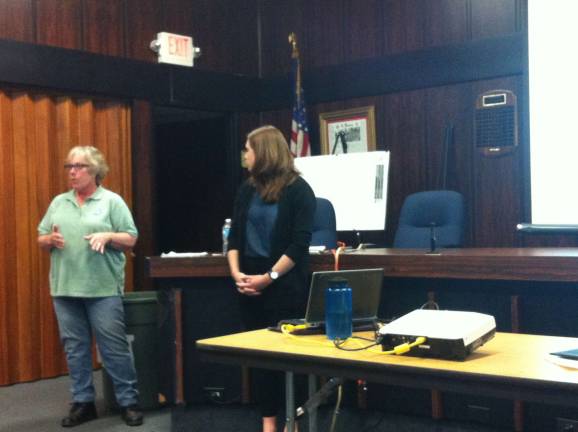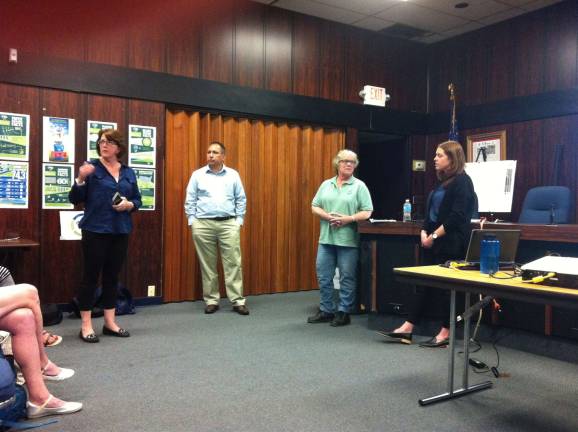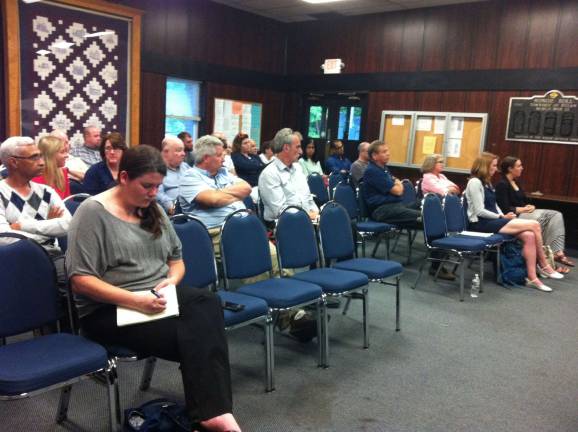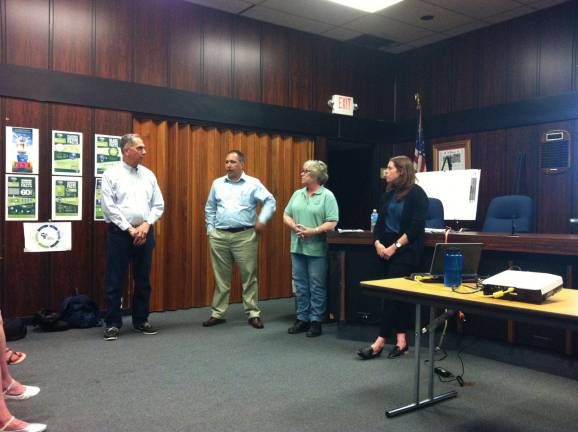EPA presents new remediation plan for Mansfield Superfund site




By Liam Donovan
Stanhope — The U.S. Environmental Protection Agency was in town Tuesday night to explain to residents the latest efforts to counteract water contamination from the Mansfield Trail Dump Superfund site.
“Residential exposure to contaminated groundwater is an unacceptable risk to current users,” Anne Rosenblatt of the EPA told attendees at the Stanhope Municipal Building, adding that EPA now intended to connect the affected homes, originally serviced through a well system, to a public water line.
The Superfund site — a wooded area near the intersection of the Mansfield bike path and Stanhope-Sparta Road — was used as a dump for septic wastes from the late 1950s through at least the early 1970s, according to the EPA. Sludge-like waste was dumped in trenches in the area and contaminated the groundwater with volatile organic compounds, which are chemicals that easily become vapors or gases.
The vapors from the contaminated groundwater underneath some nearby homes has seeped into basements, and samples taken by the Sussex County Department of Health in 2005 identified trichloroethylene (TCE) — an organic solvent used in industrial processes — in residential drinking water wells along Brookwood and Ross Roads in Byram.
Testing done by the state Department of Environmental Protection in March 2006 indicated the presence of TCE concentrations that ranged from 3.9 to 70 micrograms per liter (µg/L). Exposure to TCE and other contaminants found at the site can have serious health impacts, including damage to the liver, impairing the nervous system or increasing the risk of cancer.
Due to the levels of TCE found, between 2005 and 2006, the EPA installed carbon water filtration and treatment systems at the impacted properties to remove contaminants from their drinking water. In addition, NJDEP installed systems to reduce the intrusion of chemical vapors into the basements of five of the homes that tested positive for air pollutants. Then in 2012, the EPA removed 11,700 tons of contaminated material from the dump areas. The EPA has completed the first phase of the investigation into the nature and extent of the groundwater contamination, and evaluated various options for an alternative water supply. Adding the water line for residents would be part of the second phase of the EPA’s cleanup.
Rosenblatt explained that EPA had been removing contaminants via filtration and treatment systems, and was now proposing connection to an existing water supply as the better remedy.
“The state already agrees with the proposed remedy. It’s considered a long-term remedy. This is considered a better solution by the EPA than [water filtration],” Rosenblatt said.
After the presentation the EPA opened the meeting to public comment.
Joe Dolce of Stanhope noted “an $8.9 million dollar cost” for the proposed remedy.
“Has that funding already been approved?” Dolce asked.
“No, we can’t get the money now until there is a design and we can go to the priority panel,” EPA’s Diego Garcia replied.
“What is the likelihood of getting funding for one of the projects?” Dolce asked.
“It’s eighteen months on, so it’s difficult to say what will happen two years from now, but the project is likely to get funded,” Garcia said.
Garcia added that the EPA will continue to maintain homes under the current filtration system in the meantime.
“New homes were tested. What were the results of that?” Donna Griff of Stanhope asked.
“One new house has been found contaminated. Nineteen total homes are now affected. Anyone else interested in getting their home tested can contact the EPA,” Garcia said.
“When will you make public the company you are going to use [for the external water supply]?” Jeannie Moran of Stanhope asked.
“During the design phase,” Rosenblatt said.
The EPA said new information will be available in September at the CAG (Community Advisory Group) meeting.
“I do want to offer compliments to the DEP and the EPA… it took Chester 30 years to get water pumping in, and I think we’re moving a lot faster,” Mary Schneider of Stanhope said.
“All of us are frustrated with what has happened in the past 11 years… but I do appreciate the people,” Donna Griff said.
Stanhope resident Marilyn Parrish, an oncology nurse, emphasized the dangers of contaminated water. “This is not what we want,” she said.
The New Jersey Sierra Club released a statement in support of the new plan, urging the EPA to continue their cleanup process. But Jeff Tittel, executive director of the NJ Sierra Club. also expressed concern about how cuts to the EPA Superfund Program proposed as part of President Donald Trump’s budget could affect cleanup of the Mansfield site, as well as the numerous Superfund sites throughout New Jersey, which is the state with the most in the country.
More information on the Mansfield site can be found at <URL destination="http://www.epa.gov/superfund/mansfield-trail ">www.epa.gov/superfund/mansfield-trail
</URL>The EPA is open to public comments about the project for the next month. Comments can be sent to Anne Rosenblatt, the Remedial Project Manager, at Rosenblatt.anne@epa.gov.
Staff writer Erika Norton contributed to this report